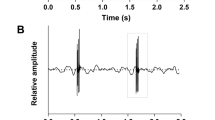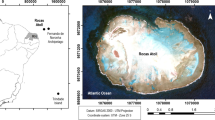Abstract
This study investigated patterns of heat loss in bottlenose dolphins (Tursiops truncatus) resident to Sarasota Bay, FL, USA, where water temperatures vary seasonally from 11 to 33°C. Simultaneous measurements of heat flux (HF) and skin surface temperature were collected at the body wall and appendages of dolphins during health-monitoring events in summer (June 2002–2004) and winter (February 2003–2005). Integument thickness was measured and whole body conductance (W/m2 °C) was estimated using HF and colonic temperature measurements. Across seasons, HF values were similar at the appendages, but their distribution differed significantly at the flipper and fluke. In summer, these appendages displayed uniformly high values, while in winter they most frequently displayed very low HF values with a few high HF values. In winter, blubber thickness was significantly greater and estimated conductance significantly lower, than in summer. These results suggest that dolphins attempt to conserve heat in winter. In winter, though, HF values across the body wall were similar to (flank) or greater than (caudal keel) summer values. It is likely that higher winter HF values are due to the steep temperature gradient between the body core and colder winter water, which may limit the dolphin’s ability to decrease heat loss across the body wall.







Similar content being viewed by others
References
Barbieri M (2005) Physiological and behavioral mechanisms of thermoregulation in bottlenose dolphins (Tursiops truncatus) in Sarasota, Florida. MS thesis in Biology and marine biology, pp 69. University of North Carolina Wilmington
Barco SG, Swingle WM, McLellan WA, Harris RN, Pabst DA (1999) Local abundance and distribution of bottlenose dolphins (Tursiops truncatus) in the nearshore waters of Virginia Beach, Virginia. Mar Mam Sci 15:394–408
Costa DP (2002) Energetics. In: Perrin WF, Wursig B, Thewissen JGM (eds) Encyclopedia of marine mammals. Academic Press, San Diego, pp 387–394
Costa DP, Williams TM (1999) Marine mammal energetics. In: Reynolds JE III, Rommel SA (eds) Biology of marine mammals. Smithsonian Institution Press, Washington DC, pp 176–217
Ducharme MB, Tikuisis P (1991) In vivo thermal conductivity of the human forearm tissues. J Appl Physiol 70:2682–2690
Ducharme MB, Frim J, Tikuisis P (1990) Errors in heat flux measurements due to the thermal resistance of heat flux disks. J Appl Physiol 69:775–784
Dunkin RC, McLellan WA, Blum JE, Pabst DA (2005) The ontogenetic changes in the thermal properties of blubber from Atlantic bottlenose dolphin Tursiops truncatus. J Exp Biol 208:1469–1480
Elsner R, Pirie J, Kenney DD, Schemmer S (1974) Functional circulatory anatomy of cetacean appendages. In: Harrison RJ (ed) Functional anatomy of marine mammals, vol 2. Academic Press, New York, pp 143–159
Esch HC (2006) Whistles as potential indicators of stress in bottlenose dolphins (Tursiops truncatus). MS thesis in Biology and marine biology, pp 60. University of North Carolina Wilmington
Folkow LP, Blix AS (1987) Nasal heat and water exchange in gray seals. Am J Physiol 253:R883–R889
Folkow LP, Blix AS (1992) Metabolic rates of minke whales (Balaenoptera acutorostrata) in cold water. Acta Physiol Scand 146:141–150
Frim J, Ducharme MB (1993) Heat flux transducer measurement error: a simplified view. J Appl Physiol 74:2040–2044
Hampton IFG, Whittow GC (1976) Body temperature and heat exchange in the Hawaiian spinner dolphin, Stenella longirostris. Comp Biochem Physiol A Physiol 55:195–197
Hampton IFG, Whittow GC, Szekerczes J, Rutherford S (1971) Heat transfer and body temperature in the Atlantic bottlenose dolphin, Tursiops truncatus. Int J Biometeorol 15:247–253
Heath ME, Ridgway SH (1999) How dolphins use their blubber to avoid heat stress during encounters with warm water. Am J Physiol 276:R1188–R1194
Irving L, Hart J (1957) The metabolism and insulation of seals as bare-skinned mammals in cold water. Can J Zool 35:497–511
Kanwisher J, Sundnes G (1966) Thermal regulation in cetaceans. In: Norris K (ed) Whales, dolphins, and porpoises. University of California Press, Berkeley, pp 397–409
Kuehl RO (2000) Design of experiments: statistical principles of research design and analysis. Duxbury Thomson Learning, Pacific Grove
Kvadsheim P, Folkow L (1997) Blubber and flipper heat transfer in harp seals. Acta Physiol Scand 161:385–395
Kvadsheim P, Folkow L, Blix A (1996) Thermal conductivity of minke whale blubber. J Therm Biol 21:123–128
McGinnis SM, Whittow GC, Ohata CA, Huber H (1972) Body heat dissipation and conversion in 2 species of dolphins. Comp Biochem Physiol A Physiol 43:417–423
McNab BK (2002) The physiological ecology of vertebrates: a view from energetics. Cornell University Press, Ithaca
Meagher EM, McLellan WA, Westgate AJ, Wells RS, Frierson D Jr, Pabst DA (2002) The relationship between heat flow and vasculature in the dorsal fin of wild bottlenose dolphins Tursiops truncatus. J Exp Biol 205:3475–3486
Noren DP, Williams TM, Berry P, Butler E (1999) Thermoregulation during swimming and diving in bottlenose dolphins, Tursiops truncatus. J Comp Physiol (B) 169:93–99
Pabst DA, Rommel SA, McLellan WA, Williams TM, Rowles TK (1995) Thermoregulation of the intra-abdominal testes of the bottlenose dolphin (Tursiops truncatus) during exercise. J Exp Biol 198:221–226
Pabst DA, Rommel SA, McLellan WA (1999) The functional morphology of marine mammals. In: Reynolds JE III, Rommel SA (eds) Biology of marine mammals. Smithsonian Institution Press, Washington DC, pp 15–72
Pabst DA, McLellan WA, Rommel S, Scott M, Irvine B, Sweeney J, Stone R, Friedlaender AS, Meagher EM, Hohn A et al (2007) Ontogeny of reproductive thermoregulation in bottlenose dolphins Tursiops truncatus. Integr Comp Biol 46(1):e235
Read AJ, Wells RS, Hohn AA, Scott MD (1993) Patterns of growth in wild bottlenose dolphins, Tursiops truncatus. J Zool Lond 231:107–123
Rommel SA, Pabst DA, McLellan WA, Mead JG, Potter CW (1992) Anatomical evidence for a countercurrent heat exchanger associated with dolphin testes. Anat Rec 232:150–156
Rommel SA, Pabst DA, McLellan WA, Williams TM, Friedl WA (1994) Temperature regulation of the testes of the bottlenose dolphin (Tursiops truncatus): evidence from colonic temperatures. J Comp Physiol (B) 164:130–134
Schmidt-Nielsen K (1997) Animal physiology: adaptation and environment. Cambridge University Press, Cambridge
Scholander PF, Schevill WE (1955) Counter-current vascular heat exchange in the fins of whales. J Appl Physiol 8:279–282
Schroeder JP (1990) Breeding bottlenose dolphins in captivity. In: Leatherwood S, Reeves RR (eds) The bottlenose dolphin. Academic Press, San Diego, pp 435–446
Scott MD, Wells RS, Irvine AB (1990) A long-term study of bottlenose dolphins on the west coast of Florida. In: Leatherwood S, Reeves RR (eds) The bottlenose dolphin. Academic Press, San Diego, pp 235–244
Sokal R, Rohlf F (1995) Biometry: the principles and practice of statistics in biological research. W.H. Freeman and Company, New York
Struntz DJ, McLellan WA, Dillaman RM, Blum JE, Kucklick JR, Pabst DA (2004) Blubber development in bottlenose dolphins (Tursiops truncatus) J Morphol 259:7–20
Waples DM (1995) Activity budgets of free-ranging bottlenose dolphins (Tursiops truncatus) in Sarasota Bay, Florida. MS thesis in Marine science, pp 61. University of California Santa Cruz
Wells RS, Scott MD (1999) Bottlenose dolphin Tursiops truncatus (Montagu, 1821). In: Ridgway SH, Harrison SR (eds) Handbook of marine mammals, vol 6: the second book of dolphins and porpoises. Academic Press, San Diego, pp 137–182
Wells RS, Scott MD, Irvine AB (1987) The social structure of free-ranging bottlenose dolphins. In: Genoways H (ed) Current mammalogy. Plenum Press, New York, pp 247–305
Wells RS, Rhinehart HL, Hansen LJ, Sweeney JC, Townsend FI, Stone R, Casper D, Scott MD, Hohn AA, Rowles TK (2004) Bottlenose dolphins as marine ecosystem sentinels: developing a health monitoring system. EcoHealth 1:246–254
Wells RS, Tornero V, Borrell A, Aguilar A, Rowles TK, Rhinehart HL, Hofmann S, Jarman WM, Hohn AA, Sweeney JC (2005) Integrating potential life-history and reproductive success data to examine relationships with organochlorine compounds for bottlenose dolphins (Tursiops truncatus) in Sarasota Bay, Florida. Sci Total Environ 349:106–119
Westgate AJ, McLellan WA, Wells RS, Scott MD, Meagher EM, Pabst DA (2007) A new device to remotely measure heat flux and skin temperature from free-swimming dolphins. J Exp Mar Bio Ecol 346:45–59
Williams TM, Noren D, Berry P, Estes JA, Allison C, Kirtland J (1999) The diving physiology of bottlenose dolphins (Tursiops truncatus): III. Thermoregulation at depth. J Exp Biol 202:2763–2769
Willis K, Horning M (2005) A novel approach to measuring heat flux in swimming animals. J Exp Mar Bio Ecol 315:147–162
Willis K, Horning M, Rosen DAS, Trites AW (2005) Spatial variation of heat flux in Stellar sea lions: evidence for consistent avenues of heat exchange along the body trunk. J Exp Mar Bio Ecol 315:163–175
Wilson B, Thompson PM, Hammond PS (1997) Habitat use by bottlenose dolphins: seasonal distribution and stratified movement patterns in the Moray Firth, Scotland. J Appl Ecol 34:1365–1374
Wissler EH, Ketch RB (1982) Errors involved in using thermal flux transducers under various conditions. Und Biomed Res 9:213–231
Worthy GA, Edwards EF (1990) Morphometric and biochemical factors affecting heat loss in a small temperate cetacean Phocoena phocoena and a small tropical cetacean Stenella attenuata. Physiol Zool 63:432–442
Yasui W, Gaskin D (1986) Energy budget of a small cetacean, the harbour porpoise, Phocoena phocoena (L.). Ophelia 25:183–197
Acknowledgments
We thank the Chicago Zoological Society, the Sarasota Dolphin Research Program, Mote Marine Laboratory, Blair Irvine and Michael Scott for their help and support of field logistics. We are grateful to the many Sarasota Dolphin Research Program volunteers who spent long hours standing in Sarasota Bay so that these data could be collected. In particular, we appreciate the help we received with data collection from Ari Friedlaender and Michelle Barbieri. We thank Dolphin Quest, the Harbor Branch Oceanographic Institute, Sigma Xi, and the American Museum of Natural History Lerner-Gray Fund for Marine Research for funding. The research described in this paper has also been funded in part by the United States Environmental Protection Agency (EPA) under the Science to Achieve Results (STAR) Graduate Fellowship Program. EPA has not officially endorsed this publication and the views expressed herein may not reflect the views of the EPA. The experiments conducted in this study comply with the current laws of the United States of America. Data were collected under NOAA Scientific Research Permit No. 522-1569 and UNCW IACUC No. 2002–009.
Author information
Authors and Affiliations
Corresponding author
Additional information
Communicated by G. Heldmaier.
Appendix
Appendix
Table 3
Rights and permissions
About this article
Cite this article
Meagher, E.M., McLellan, W.A., Westgate, A.J. et al. Seasonal patterns of heat loss in wild bottlenose dolphins (Tursiops truncatus). J Comp Physiol B 178, 529–543 (2008). https://doi.org/10.1007/s00360-007-0245-5
Received:
Revised:
Accepted:
Published:
Issue Date:
DOI: https://doi.org/10.1007/s00360-007-0245-5




